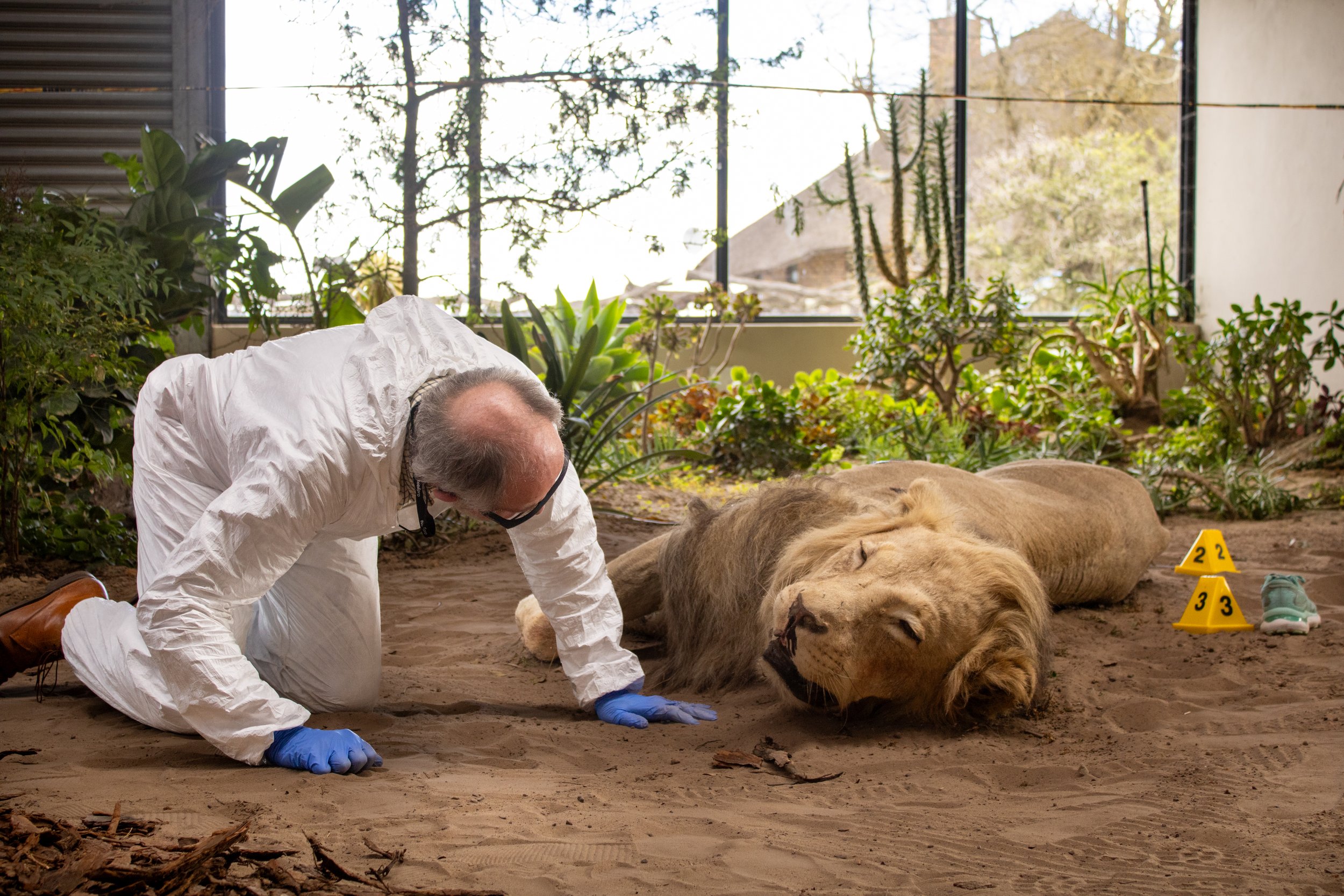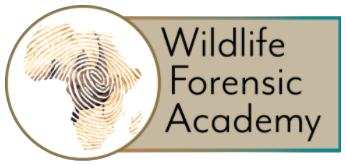
OUR FACILITIES
At the Wildlife Forensic Academy, our facilities are purpose-built to immerse students in a realistic, end-to-end wildlife crime investigation experience. Each element within our facility contributes to a comprehensive understanding of the criminal justice chain - blending forensic science, law enforcement, and environmental ethics into one unparalleled learning environment.
-

Mock Crime Scenes
Our outdoor mock crime scenes form the heart of practical training at the Academy. These scenarios feature ethically-sourced taxidermized poached animals and are enriched with realistic elements such as local flora, a shipping container, boat, car, house, and a succulent garden. These highly detailed environments allow students to practice forensic field techniques in authentic, ecologically diverse settings. Through evidence collection, scene management, and documentation, students develop the discipline and awareness required for real-world wildlife crime investigations.
-

Forensic Laboratory and Wildlife Post Mortem Suite
Our laboratory environment supports the forensic processing of wildlife crime evidence. Students gain hands-on experience in trace evidence processing, fingerprinting techniques and biological fluid analysis studies. The adjoining wildlife post-mortem suite allows for necropsy procedures, providing crucial insights into cause of death, trauma, and pathology. These facilities emphasize scientific integrity, analytical thinking, and the ethical handling of wildlife remains.
-
Wildlife Taphonomy Facility
Our dedicated wildlife taphonomy facility offers a unique opportunity to study decomposition processes in various environmental conditions. This open-air site is essential for understanding post-mortem interval estimation, scavenger activity, and the natural breakdown of soft and hard tissue. The insights gained here support more accurate recovery of buried or long-deceased wildlife victims and refine time-of-death calculations. It’s an invaluable tool for training in long-term forensic ecology and clandestine grave investigations. Read more about this unique facility below.
-

Mock Court Room
The mock courtroom provides an essential platform for understanding the legal dimension of wildlife crime. Here, students simulate courtroom proceedings, gaining experience in presenting forensic findings, delivering expert testimony, and navigating cross-examinations. This space develops students’ confidence, communication skills, and understanding of how scientific evidence influences judicial outcomes - preparing them to be compelling, credible voices in the legal arena.
-

Forensic Entomology
Equipped with microscopes and entomological reference materials, this facility trains students to collect entomological data from crime scenes (i.e. our taphonomy research facility) and identify key species and interpret their role in the post-mortem timeline. Accurate entomological analysis can reveal crucial information about time and location of death, making this an essential skill in wildlife forensic investigations.
-

Classroom
Overlooking the rest of the facility, the upstairs classroom serves as a dynamic learning hub for lectures, debriefings, and collaborative analysis. Outfitted with modern presentation tools and interactive displays, it is where theory meets practice. Students gather here to reflect on case simulations, interpret forensic findings, and engage in academic discussions that deepen their understanding of wildlife forensic science and conservation law. This space fosters critical thinking and interdisciplinary learning in a professional, structured environment.
-

Observation Room
To enhance reflective learning and procedural accuracy, our indoor training areas are equipped with CCTV cameras that record student activities during practical assessments. These recordings allow instructors to provide detailed feedback, highlighting both strengths and areas for improvement. This technology supports the development of best practices in evidence handling, scene integrity, and forensic discipline - ensuring students graduate with the skills and mindset required for professional excellence.
-

Outdoor Training Space
Understanding the broader ecosystem is key to effective wildlife crime investigation. In this outdoor training area, students learn practical tracking techniques, basic survival skills, and ecological awareness essential for operating in remote field conditions. The curriculum includes identifying animal signs, navigating natural landscapes, and understanding the local environment - all of which enhance field efficiency and contribute to contextual forensic interpretation.
Wildlife Taphonomy Facility
One of the foci of the Wildlife Forensic Academy’s research programme involves studying the decomposition of wildlife carcasses. Though it may sound morbid and a tad gruesome, it is critically important research in the fight against international wildlife crime. We have provided answers to some common questions about the research below:
Wildlife Forensic Academy Wildlife Taphonomy Research Facility | Drone videography by Wesley Gerber (@bears_eyeview_)
-
The research being conducted at this facility and its surrounds replicates wildlife crime scenes involving animal bodies in South Africa (e.g., poaching fatalities) towards assisting the Police and Environmental Management Inspectorate to reconstruct the timing and circumstances surrounding suspicious wildlife deaths. We aim to understand how decomposition varies between different species of animals, seasons, and environments. The facility also provides a space for us to naturally skeletonise wildlife bodies, with the skeletons being accessioned into a faunal teaching and research repository. We also provide study abroad programs at the academy and research projects for international students.
-
Retrospectively analysing decomposition from wildlife forensic cases is a possible route to better understand local decay processes of the bodies of wildlife. However, the comprehensiveness of our understanding will always be limited by the quality of data, and a lot of contextual information is often missing from cases, for many reasons – many beyond our control. Like human medico-legal death investigations, those involving wildlife often provide only a snapshot of the decomposition process, rather than a robust understanding of how the process plays out in different circumstances. We absolutely need the latter to be able to build models of decomposition that facilitate forensic investigative leads, estimating the time-since-death and reconstructing the circumstances around an animal’s death. Internationally, there is a critical lack of research in this domain, and the effects of this knowledge deficit are felt particularly acutely in South Africa given our high incidence of wildlife crime. By better-understanding the processes that take place after an animal dies, we could provide authorities with more leads and better evidence, expediting the dispensation of justice for animals unlawfully and cruelly killed for the international illegal wildlife trade.
-
Yes! This research – on wildlife carcasses – is the first of its kind in South Africa to implement a transdisciplinary approach for understanding the roles of vertebrate and invertebrate scavengers on the rate of decomposition across a diversity of wildlife species, and how environmental variables modulate the activity of the decomposers in different habitats and across different seasons. Our research approach draws on that developed and implemented by the Cape4Taph Research Group at the University of Cape Town who have pioneered forensically realistic experimental decomposition research design and achieved a number of world-firsts in their work. We have brought this globally-leading research approach to the Wildlife Forensic Academy to give law enforcement the best chance for solving wildlife crime cases where the only evidence left behind is a butchered and decaying animal body. And we are taking it one step further: in partnership with Buffelsfontein Nature Reserve, we have the opportunity to study decomposition across the full breadth of the reserve, meaning our research is being conducted on the largest “body farm” in the world! This will allow us to answer burning questions about decomposition research design that many other “body farms” have not been able to because they are too small, making the Wildlife Forensic Academy a trailblazer not just in wildlife forensics, but in the broader fields of forensic taphonomy and entomology, too!
-
Vertebrate scavengers (e.g., Cape grey mongoose, porcupine, and caracal) are well-known to significantly impact the rate and pattern of decomposition. In the nearby city of Cape Town, previous research by Cape4Taph has shown that the Cape grey mongoose is a major scavenger of decomposing bodies. Elsewhere in the country, we have documented scavenging by jackals, hyenas, various other mongoose species, and numerous carrion bird species (e.g., crows, vultures, and Marabou storks). Scavengers can also remove parts of animal bodies and scatter them into the surrounding bush for safe consumption. Knowing where to look for these scattered pieces is essential to ruling out (or confirming!) removal for illegal wildlife trade purposes (e.g., lion paw removals for traditional medicine).
-
Insects play a significant role in decomposition, and knowledge regarding their lifecycles and behaviour can help the law enforcement establish time-since-death and season of death – the central focus of the discipline of forensic entomology. The forensic entomology of wildlife bodies is poorly understood, with only three animal species having been studied in South Africa (impala, kudu, and white rhino). Many other species besides these are targets for poaching and illegal wildlife trade, so it is important to understand if (and how) the interactions of insects with an animal’s body differs between species. We also have a poor understanding of the interactions between insects and vertebrate scavengers in African contexts (where significant interactions have been documented elsewhere in the world, e.g., Australia), so it is imperative we establish data on the synergistic interactions between all the agents of decomposition for the variety of wildlife species that are the targets of wildlife crime.
-
All the animal bodies used in our research have been kindly donated to the Wildlife Forensic Academy by stakeholders and partners of the Academy. All animals are either victims of accidents, wildlife crime or have died due to natural causes. We follow strict adherence to all required ethical and legal obligations to conduct scientific research.
-
Absolutely! Particularly for conservation. We have a fairly robust understanding of landscape-level ecology around decomposing animals (known as carrion ecology), but a poor understanding of what happens at the individual carcass level – the level we are interested in for wildlife forensics. By looking closely at the decompositional and ecological processes that emerge around individual animal bodies, we stand to gain much deeper insight into the nuanced interactions between the multitude of species that utilise a decomposing animal body, be it for food, shelter, a breeding ground, or a nursery. Vultures alone deliver $1.8 billion worth of ecosystem services per year, just in southern Africa! Imagine how much all the decomposers together contribute… Having a better understanding of the biology, lifecycles, and activities of these various species could help us shape and manage much healthier ecosystems with tangible economic benefits for our country and beyond.
-
Should you have any questions or concerns about the research not answered here, you are welcome to address your queries in writing to Dr Devin Finaughty (WFA Research and Strategic Partnerships) at devin@wildlifeforensicacademy.com


